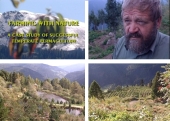I set up my raised veggie beds this last spring, and am having strange fungal growths in the beds. The growths appear in all 3 raised beds. The bed layers in the upper two beds consist of dirt from the swale, then amendments, then cardboard, then llama manure, then 6'' or more of new straw, then composted straw or composted leaves, then fine
compost (purchased). The third bed is slightly different, mostly because it has wood chips instead of new straw.
When I planted the veggies, I made a coffee-can sized hole in the bed down to the cardboard, made a smallhole in the cardboard, filled the hole with the sifted compost, and put in the transplant. Then I set up drip irrigation and mulched with straw.
The first few weeks after I planted the beds, they were very moist, but since then it has, at times, been hard to keep the plants watered enough. I had to keep increasing the length of time the drip system was on. Now the plants aren't severely wilting in the afternoon, the corn isn't bending over halfway up the stalk, and the squash blossoms aren't all dying on a hot afternoon. Many of the fungal growths (if that is what they are) appeared when the beds were quite wet. But some appeared when it was on the dry side, though maybe it was locally wet. They are definitely clustered around the drippers.
Does anyone know what these growths are, and whether I should worry about them? I am guessing that the main cause is that some areas are getting more water than others (I used some new drippers and some old ones which maybe were semi-clogged), and that water retention in my beds varies greatly (straw areas near the plants vs. sifted compost immediately around each plant). Maybe the fungi are from the compost I bought. Though it seems like fungal spores would be pretty ubiquitous. In case you are wondering, no, I haven't seen any mushrooms, nor have I looked at the soil underneath for mycelia (too dark out now to look!).
Also, a friend tells me I should be adding more manure to the beds this fall. Is this necessary? The soil under the cardboard is pretty good. It was a garden for about 6 years and we added manure (in varying amounts) every year.

















































 young Honey Mushrooms by frankenstoen, on Flickr
young Honey Mushrooms by frankenstoen, on Flickr



 2
2








